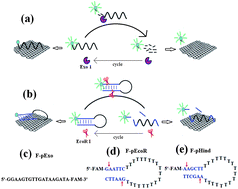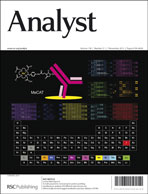A general fluorescent sensor design strategy for “turn-on” activity detection of exonucleases and restriction endonucleases based on graphene oxide†
Abstract
Using graphene oxide (GO) as a nanoquencher, a universal sensor design strategy was developed on the basis of significantly different binding affinities of GO to single-stranded DNAs (ss-DNAs) with different lengths. The proposed sensors could be used for the activity detection of both exonucleases and restriction endonucleases. To achieve this, a single-labeled fluorescent oligonucleotide probe, which had a single-stranded structure or a hairpin structure with a long single-stranded loop, was used. Such a probe could be efficiently absorbed on the surface of GO, resulting in the quenching of the fluorescent signal. Excision of the single-stranded probe by exonucleases or site-specific cleavage at the double-stranded stem of the hairpin probe by restriction endonuclease released fluorophore-labeled nucleotide, which could not be efficiently absorbed by GO, thus leading to increase in fluorescence of the corresponding sensing system. As examples, three sensors, which were used for activity detection of the exonuclease Exo 1 and the restriction endonucleases EcoR I and Hind III, were developed. These three sensors could specifically and sensitively detect the activities of Exo 1, EcoR I and Hind III with detection limits of 0.03 U mL−1, 0.06 U mL−1 and 0.04 U mL−1, respectively. Visual detection was also possible.


 Please wait while we load your content...
Please wait while we load your content...